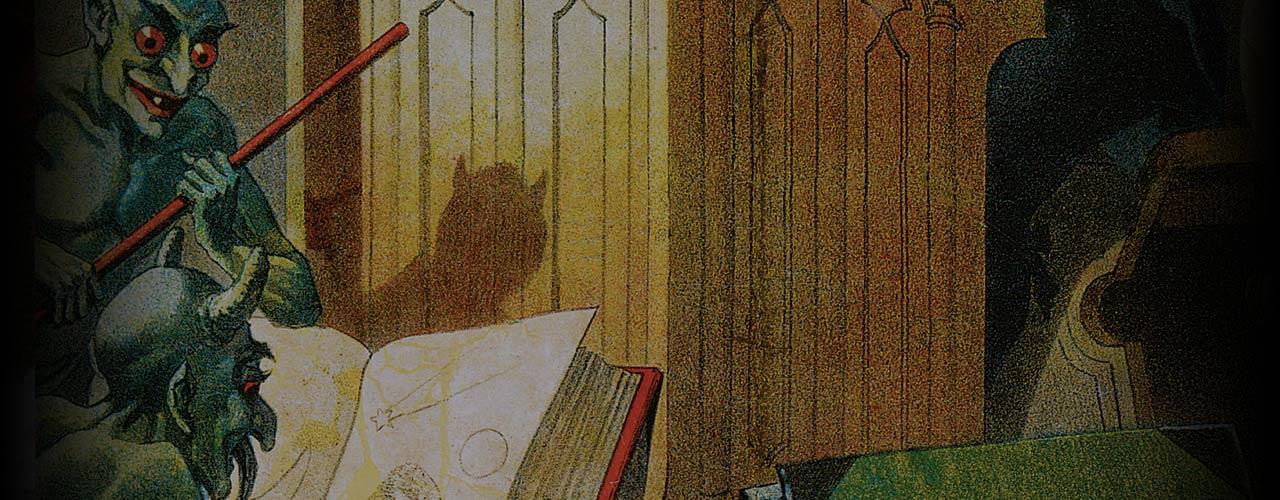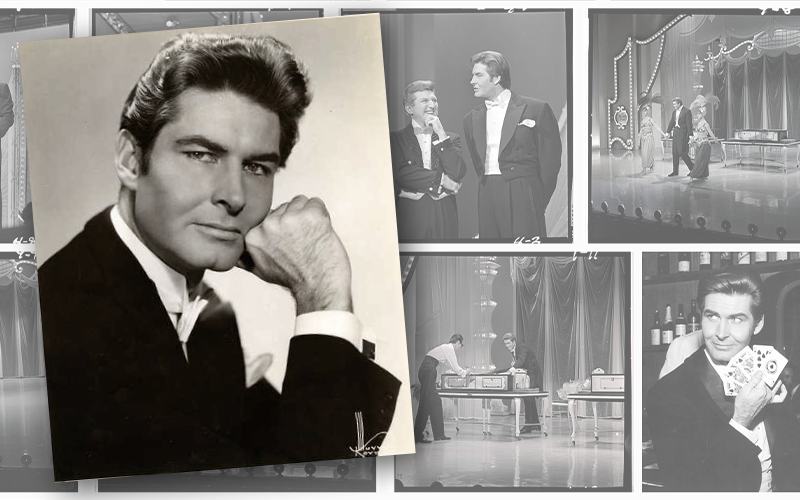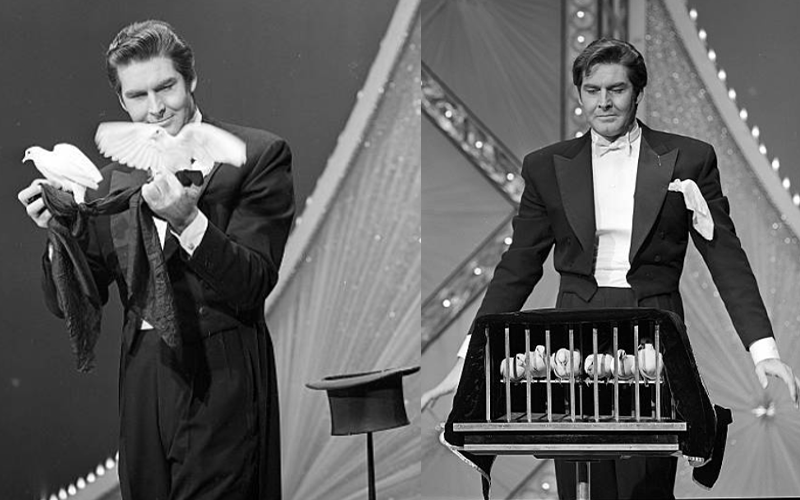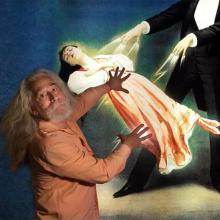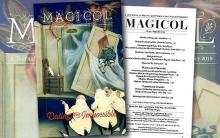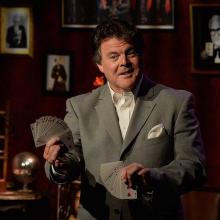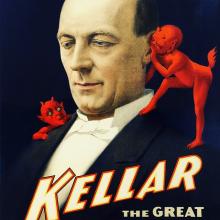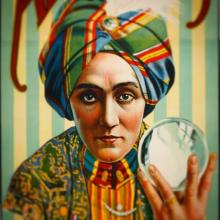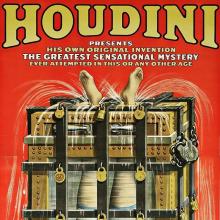Submitted by Jamy Ian Swiss on
Channing Pollock
Way back in Take Two #4, I looked at our greatest “dove worker” of recent times, Lance Burton, one of the most successful American magicians of his generation. And more recently, I offered tribute to another dove man, the legendary Johnny Thompson, (whose massive collected work The Magic of Johnny Thompson, I co-authored, and is now in its second printing). Along the way, I’ve also written half a dozen Take Two pieces about renowned acts in the genre of manipulation magic—of which sleight-of-hand dove magic is a sub-category—including essays about Lukas Lee and Yu-Ho-Jin, Jean Valton, Fred Kaps, Cardini, Fantasio, and Silvan.
In the Take Twos about Burton and Thompson, I mentioned one other legendary dove worker and manipulator, who inspired Burton along with an entire generation of young magicians—the inimitable Channing Pollock. Perhaps “inimitable” is not precisely the correct word, because while Pollock was ultimately one-of-a-kind, he was also the most imitated performer of his time. In fact, between Cardini and Pollock, it’s probably impossible to determine which one engendered a greater number of imitators in their respective eras.
And in the tradition of dove magic, no act was more influential than Pollock’s.
His act was iconic, and in many respects remains so to this day. Virtually every dove act—including Thompson’s “The Great Tomsoni & Co.”—features at least two of Pollock’s signature creations: the Double Dove production, in which two birds are simultaneously produced from silk scarves; and Dove to Silk, the midair transformation of a dove into a silk handkerchief, a feat that has historical precedents, but which Pollock integrated into the structure of a bird act in a manner that has routinely been adopted by other practitioners ever since.
Born in 1926 in Sacramento, California, Channing Pollock was introduced to magic at the age of 21—a late start by the standards of the time—when he saw a pitchman selling trick Svengali decks at a state fair. Like many beginning magic students, he proceeded to the library, and repeatedly checked out a copy of Jean Hugard’s Modern Magic Manual, a neoclassic text published in 1939. Passionately hooked on magic, he dropped out of college and moved to Los Angeles, where he enrolled in the famous Chavez Studio of Magic. Founded in 1941, this was the first school for magicians approved to formally accept veterans under the G.I. Bill, by the California State Department of Education. The Chavez College of Manual Dexterity and Prestidigitation offered training in advanced sleight-of-hand and manipulative magic, primarily for stage performers.
In later years, Pollock would declaim creative credit for his celebrated act, while accepting credit for his on-stage persona. But within this notable fact may indeed lie the greatest lesson of the Channing Pollock act. While the basic elements of the act are more or less effects as the Chavez Studio taught them—namely, manipulation magic with cards, cigarettes, and billiard balls—Pollock’s act is a textbook demonstration that the ability to do tricks is not the same as the ability to perform them. Sleight-of-hand is the tool, and magic is the medium, but it is the artist who brings something original and creative to the work, along with the distinctive stamp of his or her own personality and point of view, who will create an indelible experience for the audience.
But then again, it wasn’t just card fans and productions that made the act what it was. There was, at the core, the dove magic. Although magicians have been making the occasional bird appear for centuries—from pigeons to parakeets to canaries—it was Abe Cantu who inspired Pollock, and Thompson as well. Cantu, a Mexican magician who performed wearing a dressy version of a serape, would repeatedly conclude each routine in his act with the appearance of a bird. Pollock and Thompson, with little or no source material to work from, each worked out their own methods for the barehanded bird productions that characterized their work, which dramatically contrasted the prop-based bird magic that was far more commonplace (and much easier to do). And both Pollock and Thompson set out to construct acts in which the bird magic was structured and routined, without the need for other significant tricks between the appearances. Decades later, when they finally compared notes, they discovered striking similarities in the methodological techniques and dramatic principles they had each devised.
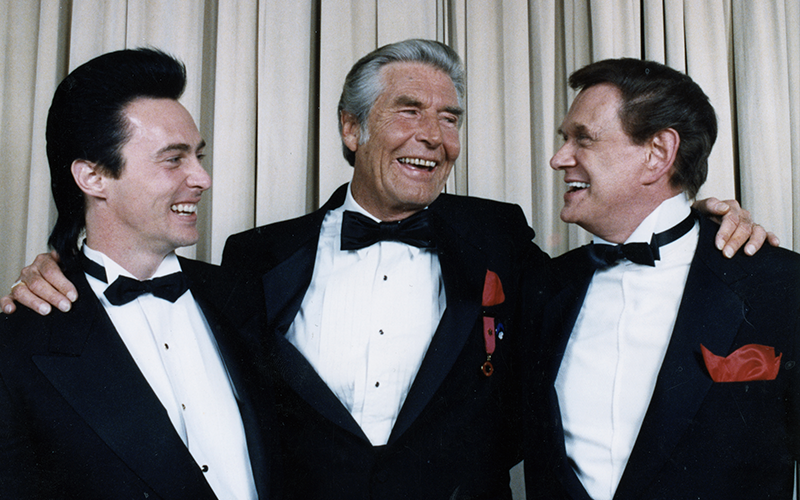
Chavez-style card manipulations plus original magic with doves formed the content of Pollock’s core act, but what truly set it apart was Pollock himself. David Copperfield would later refer to him as “the James Bond of magic,” and one glance at Pollock in his impeccably tailored Savile Row tailcoat confirms the claim. He cut a statuesque figure at six-foot-four-inches, was devastatingly handsome, and he carried himself with both elegance and gravitas, creating a riveting effect the instant he walked on stage. It would be a mistake to dub the character arrogant; rather, Pollock was cool and dispassionate throughout the act, while the magic—breathtakingly beautiful—was executed without the slightest sign of effort. The absolute seamlessness of the technique remains wondrous when I view it today for the umpteenth time. Pollock is electrifying, almost inhumanly godlike in his perfection, never cracking a smile until he at last acknowledges his humanity with a grin in the closing seconds. The constraints of the form, the abstract minimalism of the props, the sheer beauty of the magic, and the detached demeanor, all combine to deliver an unforgettable performance. In the words of Lance Burton: “Seven doves, seven silks, seven packs of cards—seven minutes.”
Pollock struggled at first to build a show business career. But after two years of polishing his act in the trenches, Jay Marshall recommended him to his own agent, showbiz legend Mark Leddy, and it was Leddy who brought Pollock to the attention of Ed Sullivan. Once Pollock appeared on Sullivan’s “Toast of the Town” (the predecessor to the famed “Ed Sullivan Show”) in 1954, bookings started to pour in, and Pollock was well on his way. He toured widely in both the U.S. and Europe, making multiple appearances at the London Palladium, and eventually performing for the likes of President Dwight D. Eisenhower, Queen Elizabeth II, and even at the wedding of Prince Rainier and Grace Kelly.
Pollock’s success was so thorough that his act became the most copied of his time, with countless imitators booking their acts into American and European nightclubs. But try as they might, no one could truly duplicate Pollock’s onstage persona—and his perfection. Notably, Johnny Thompson took a different approach. With Pollock’s permission, Thompson worked out an act that spoofed Pollock’s style. The bird magic was equally stunning, but the character was that of a haughty buffoon. Where Pollock was assisted on stage by his breezily poised first wife, Naomi, the bumbling Great Tomsoni was assisted by the brash, gum-chewing, perpetually unimpressed Trixie, who was hilariously portrayed by Thompson’s actress wife, Pamela Hayes. Both magicians would influence the award-winning act of Lance Burton; Pollock as early inspiration, and later Thompson as a mentor and collaborator.
Pollock appeared in the 1959 film European Nights, a sort of travelogue of variety acts seen performing throughout Europe. A year later, at the height of his success as a highly paid variety performer, Pollock took the extraordinary step of abandoning his magic act in order to pursue a career as a film actor in Europe. He appeared in a number of films over the next four years, including I Moschettieri del Mare (1960), Lo Sceicco Rosso (1962), Rocambole (1963), and starred in the title role of Judex (1963) where he played a character who, in the course of the story, brings a dead dove to life.
Tiring of life in Europe, Pollock returned to the United States in 1964, where, for a time, he returned to magic, and also acted on a number of television shows, including Bonanza and Daniel Boone. In 1969 he retired completely from show business. With his third wife, Cori, he relocated to Northern California to established an organic farm, and the couple moved into a beautiful glassed-in home overlooking the Pacific Ocean. Eventually they moved back to Las Vegas for their final retirement.
I encountered Pollock a number of times late in his life. While I certainly did not know him well, I had the pleasure of attending a small dinner celebrating his birthday at his and Cori’s home in Las Vegas. It was a privilege to spend time with him. An unmistakable sophisticate, he was utterly gracious and genteel company. Right until the end of his life he was an ever-gentle presence and a generous teacher to those lucky enough to be around him. He died in Las Vegas in 2006 at the age of 79, and the entire world of magic mourned an acknowledged master—one who set the world of magic on fire with an act that remains a standard to this day, despite his having made a living from it for little more than a decade.
Countless adolescents, myself included, spent our youths endlessly paging through magic catalogs, fantasizing ourselves as the sophisticated nightclub performers who invariably served as catalog illustrations accompanying the trick descriptions—and Channing Pollock was that illustration incarnate. As Teller said, in the aftermath of his death, “He was the guy with the movie-star looks who actually did the cool, suave, sexy standup act we all dreamed about doing when we grew up. He made himself an archetype, and he made it look seductively easy.”
Channing Pollock
European Nights (1959)
While there are a number of videos that can be found online of Channing Pollock performing, almost all of them are different versions of the same core act, recorded at different stages of his career. The definitive version, and the only one readily available in color, is his feature segment in the 1959 film, European Nights. Please, in order to fully appreciate what you’re about to see, expand the browser to the max, turn up the sound, put aside the smart phone, and watch in its entirety these five remarkable minutes. Ladies and gentlemen, I present to you: Channing Pollock!
—♦—
Channing Pollock 1956
Here is an older version of the act, recorded in black-and-white in 1956. The music aside, this is almost the same act as presented in European Nights, except that in this performance, we see his actual finale. In reality, the Dove to Silk was usually the penultimate effect, and not the closer as depicted in European Nights. Also note that in this clip, you can see the smile that the otherwise aloof Pollock allows to appear only when it came time to accept his final applause.
—♦—
Private Collection of Magic Paladino | Channing Pollock
While viewing every online film of Pollock that I could find, I was surprised and thrilled to come upon this unusual twenty-minute collection of mostly black-and-white performance pieces that were filmed for Italian television, my guess being approximately 1960 or thereabouts. Magicians who have not seen this will doubtless be as fascinated as I was to discover Pollock doing some close-up magic, including the Cups and Balls, and a version of the popular packet trick known as “Wild Card,” which was first marketed in this form in about 1960. (This was marketed by Frank Garcia and Tannen’s Magic, although the trick was actually the creation of British magician Peter Kane.)
On the stage magic side, we get to see Pollock performing material mostly in the Chavez tradition, some of which is obviously so polished that it clearly served him well when he needed to add stage time to the core act. These routines include a beautiful version of the Multiplying Candles; manipulative magic with lit cigarettes; a classic billiard ball routine; and a version of the Floating Ball (that includes a lovely repeat moment of the ball travelling entirely around his body).
We also get so see a version of the Multiplying Bottles; the Sword Suspension, a large scale illusion; and eventually a variety of dove work, of which some is framed in brief set pieces in which the pretense is that of Pollock visiting a home and performing up close for three young children. Occasionally these segments open or close with deliberately obvious trick photography, to make other people appear or disappear at the start or finish of the piece, in the time-honored TV tradition that every television director thinks is his own special brand of original genius.
The substantial compilation concludes with a segment recorded much later in his life, long after Pollock’s retirement. Sporting silver hair and looking elegant as ever, his stylish and restrained demeanor remains intact as he performs some of his signature card manipulation, including a version of the Diminishing Cards.
—♦—
Meet Channing Pollock
Finally, for students, in my research I came upon this interesting essay, connected with the classic Criterion Collection film catalog, which focuses a bit on Channing Pollock’s film career, and provides some interesting details and commentary about those films.
SEE TAKE TWO INDEX

